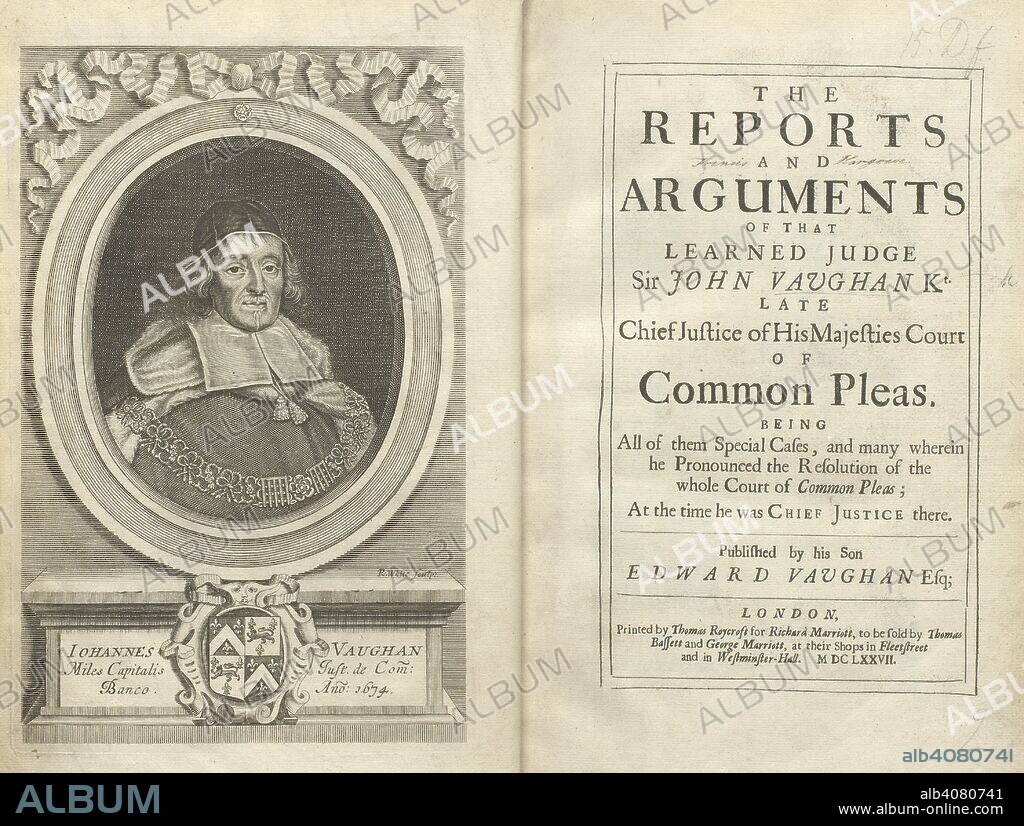alb4080741
The jurors who refused to convict William Penn in 1670 were fined and imprisoned for contempt of court because they returned a verdict with which the judge disagreed. One juror, Edward Bushell, refused to pay the fine and instead sued for a writ of habeas corpus which was received by the Court of Common Pleas, presided over by Sir John Vaughan (d. 1674). Portrayed here on the frontispiece of a collection of his most famous judgments, Vaughan ruled that the imprisonment of the jury in this case was contrary to the terms of Magna Carta, and so he declared it illegal for jurors to be punished for the verdicts which they had reached. His decision, in what became known as Bushell’s Case, became a landmark ruling that ensured the future autonomy of English juries. It also had consequences for jurisprudence in North America, where Penn, inspired by the trial, incorporated Magna Carta into the laws of his new colony. The reports and arguments of ... Sir J. V. ... Being all of them special cases, and many wherein he pronounced the resolution of the whole court of Common Pleas; at the time he was Chief Justice there. London, 1677. Source: 513.k.17, frontispiece and title page. Language: English.

|
Ajouter à une autre Lightbox |
|
Ajouter à une autre Lightbox |



Avez-vous déjà un compte? S'identifier
Vous n'avez pas de compte ? S'inscrire
Acheter cette image

Légende:
Voir la traduction automatique
The jurors who refused to convict William Penn in 1670 were fined and imprisoned for contempt of court because they returned a verdict with which the judge disagreed. One juror, Edward Bushell, refused to pay the fine and instead sued for a writ of habeas corpus which was received by the Court of Common Pleas, presided over by Sir John Vaughan (d. 1674). Portrayed here on the frontispiece of a collection of his most famous judgments, Vaughan ruled that the imprisonment of the jury in this case was contrary to the terms of Magna Carta, and so he declared it illegal for jurors to be punished for the verdicts which they had reached. His decision, in what became known as Bushell’s Case, became a landmark ruling that ensured the future autonomy of English juries. It also had consequences for jurisprudence in North America, where Penn, inspired by the trial, incorporated Magna Carta into the laws of his new colony. The reports and arguments of ... Sir J. V. ... Being all of them special cases, and many wherein he pronounced the resolution of the whole court of Common Pleas; at the time he was Chief Justice there. London, 1677. Source: 513.k.17, frontispiece and title page. Language: English.
Crédit:
Album / British Library
Autorisations:
Modèle: Non - Propriété: Non
Questions sur les droits?
Questions sur les droits?
Taille de l'image:
4377 x 3304 px | 41.4 MB
Taille d'impression:
37.1 x 28.0 cm | 14.6 x 11.0 in (300 dpi)
Mots clés:
17E SIECLE • 17EME S • DIX-SEPTIÈME SIÈCLE • DOCUMENT • ECRITURE LIVRES • ÉVÉNEMENT • FRONTISPICE • LIBERTE • LIVRE (OUVRAGE) • LIVRE • LIVRES • PORTAIT • PORTRAIT • POTRAIT • TEXTE • XVIIE SIECLE
 Pinterest
Pinterest Twitter
Twitter Facebook
Facebook Copier le lien
Copier le lien Email
Email
